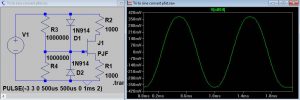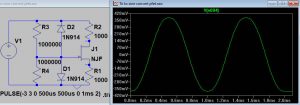[ad_1]
…for I have used Analog Devices’ wonderful LTspice to have a quick look at the p-jfet and n-jfet versions of the Middlebrook & Richer trinagle to sine wave converter.
And here are the results, both looking delightful.
 First p-jfet – waveform is the output taken across R1.
First p-jfet – waveform is the output taken across R1.
Input is a 1kHz triangle wave, set to oscillate between -3V and +3V. Bumping these up to ±3.1V or down to ±2.9V made the waveform look less nice.
Changing R1 to 100Ω made little difference to the output amplitude, but the input triangle needed tweaking in amplitude to get a nice shape again.
And here is the n-jfet version
In this case the diodes have to be reversed (and have to be there), otherwise the circuit produces a non-symmetrical mess.
Again, 3V seemed about the right amplitude of triangle wave.
In each case, the jfets are the default LTspice components.
BTW, to make a triangle wave in LTspice, set a voltage source to pulse, then set rise and fall times to be equal to half the total cycle time
Slight flattening of the right end of the waveform in the images is due to the triangle stopping after 2ms while the simulation continues for 2.1ms
[ad_2]
Source link

